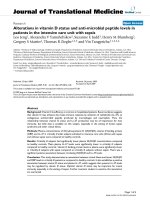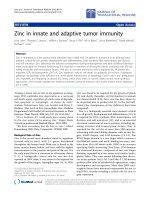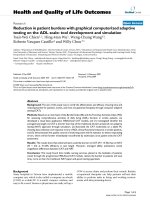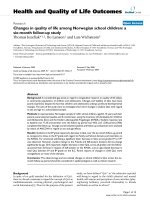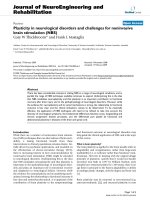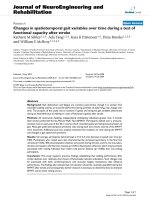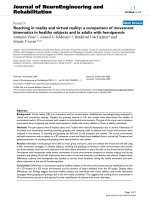báo cáo hóa học: " Training in critical care echocardiography" pptx
Bạn đang xem bản rút gọn của tài liệu. Xem và tải ngay bản đầy đủ của tài liệu tại đây (169.09 KB, 5 trang )
REVIE W Open Access
Training in critical care echocardiography
Paul H Mayo
Abstract
Echocardiography is useful for the diagnosis and management of hemodynamic failure in the intensive care unit
so that competence in some elements of echocardiography is a core skill of the critical care specialist. An
important issue is how to provide training to intensivists so that they are competent in the field. This article will
review issues related to training in critical care echocardiography.
Introduction
Echocardiography has unparalleled utility in the inten-
sive care unit (ICU). It allows the intensivist to assess
rapidly the anatomy and function of the heart in
patients with hemodynamic failure. This allows the clini-
cian to make immediate visual diagnosis and to guide
the ongoing management of the case. Its ease of use,
bedside utility, and quality o f information make cardiac
ultrasonographyakeyskillforthefrontlineintensivist.
Given the importance of echocardiography in the ICU,
an i mportant issue is how to provide training to intensi-
vists so that they are competent in the field. This article
will review the issues related to training in critical care
echocardiography (CCE).
This article is of interest for two groups of intensivists.
For the intensivist who does not have training but who
seeks to develop competence in CCE, this article will be
helpful in providing a guide to the training process. For
the intensivist who already has training but who has the
additional responsibility to train other clinicians to
become competent in CCE, this article will be helpful as
a framework for developing teaching process.
In the United States, there are approximately 6,000
intensivists at the attending level who need training in
CCE. These are frontline attendings who seek to use
CCE as a primary bedside imaging modality and who
work on a full-time basis in the ICU. Some of these are
faculty intensivists who have responsibility for critical
care fellows who need training in CCE. In Europe, it is
difficult to estimate the number of intensivists who need
training, because each country has indiv idual patterns of
unit staffing. It is likely that the numbers are similar in
magnitude to the United States. In Australia, there are
approximately 400 fulltime intensivists who need train-
ing in CCE. It is not possible to estimate the numbers
in other countries of the Asia Pacific region, Asia,
Africa, or South America. China and India alone may
add many thousands more to the count in the coming
years. The challenge to the individual intensivist is how
to achieve competence in the CCE, whereas the chal-
lenge at the system level is how to design training meth-
ods that can efficiently and effectively train many
thousands of intensivists [1-3].
A key element to the design of a process of training is
to define explicitly the goals of training. Competence is
the goal of training. To design a trainin g program, there
must therefore be a specific definition of competence in
CCE. In 2008, a working group comprised of representa-
tives from France and the United States c oauthored a
statement that defined competence in critical care ult ra-
sonography [4]. The document, American Colle ge of
Chest Physicians/La Société de Réanimation de Langue
Française Statement on Competence in Critical Care
Ultrasonography, includes explicit discussion of CCE.
CCE is divided into two levels of competence: basic
level CCE and advanced level CCE. Basic level CCE
emphasizes a goal-directed examination of the heart
with a limited number of standard views (e.g., paraster-
nal long and short axis, apical four chamber, subcostal,
and inferior vena cava), which are used to categorize
shock state and to guide management of the patient
with hemodynamic failure. Color Doppler is used as a
method to screen for severe valvular dysfunction, but
basic CCE includes no other compo nent of the Doppler
examination. Competence in basic level CCE is a key
element of competence in critical care ultrasonography.
Correspondence:
Long Island Jewish Medical Center, 270-05 76
th
Avenue, New Hyde Park,
New York 11040, USA
Mayo Annals of Intensive Care 2011, 1:36
/>© 2011 Mayo; licensee Springer. This is an Open Access article distributed under the terms of the Creative Commons Attribution
License ( which permits unrestricted use, distribution, and reproduction in any medium,
provided the original work is properly cited.
Advanced-level CCE requires that the clinician
achieves competence in aspects of echocardiography
that are part of standard cardiology-type echocardiogra-
phy, in addition to achieving competence in elements of
echocardiography that are particular to critical care
medicine. Competence in advanced-level CCE requires a
long course of study similar in complexity to the cardi-
ologist who is trained in echocardiography. It includes
training in transesophageal echocardiography (TEE).
Competence in advanced level CCE is not a key element
of competence in critical ca re ultrasonography. The
majority of intensivists do not have the time, the inter-
est, or the n eed for advanc ed level of training. It is not
clear what proportion of intensivists should acquire
advanced level. One approach in a large ICU that is
staffed by a full-time intensivist team is for several team
members to h ave advanced CCE training, whereas all
other team mem bers have basic CCE skill. This allows
ready access to advanced CCE capability, should the
clinician with basic level CCE skill need backup.
The importance of the Statement on Competence is
that it clearly defines competence in both types of CCE.
It therefore has utility for both the trainee and the trai-
ner, because it provides a road map for training. It has
been adopted as the foundat ion document for a multi-
national consensus statement on training in critical care
ultrasonography.
Following the development of the Statement on Com-
petence, a working group met in 2009 to develop guide-
lines for training in critical care ultrasonography.
Represent atives from major critical care organization s of
Europe, North America, America, the Middle East, and
the Asia-Pacific region met under the aegis of the Eur-
opean Society of Intensive Care Medicine. The resulting
document, I nternational Expert Statement on Training
Standards for Critical Care Ultrasonography, is based on
consensus of the group and addresses the question of
how to train to become competent in both basic and
advanced CCE [5].
For training in basic CCE, the working group decided
that the theoretical component of training should
include a minimum of 10 hours of course work, com-
bining lecture, didactic cases, and image interpretation.
Thelearningmayutilizeablendoflectureformatand
internet-based material. For training in image acquisi-
tion, a minimum of 30 fully supervised studies is sug-
gested as a reasonable target. Initially, training scans
may be performed on normal subjects. A key part of
training includes a component of bedside scanning of
patients in the ICU under the supervision of a local
expert who is competent in basic CCE. For training in
image interpreta tion, the trainees should be exposed to
a comprehensive collection of abnormal images, because
it is not expected that they will see all important
pathology during their image acquisition training. The
trainee should keep a logbook of scanning activity and
make formal readings of their scans under supervision
of their trainer. Training in TEE is an optional compo-
nent of basic CCE.
Training in advanced CCE requires a minimum of 40
hoursofcourseworkusingthesametechniques
described for basic CCE. Image acquisition training
requires a suggested minimum of 150 transthoracic
(TTE) and 50 TEE studies performed under the direct
supervision of a local expert . In other respects, training
methods are similar as with basic CCE, using blended
techniques for cognitive training, image interpretation
from a comprehensive image collection, and initial train-
ing with normal subjects followed by extensive bedside
scanning under direct supervision of a local expert.
The working group decided that a formal certification
process for basic CCE was not required but that a certi-
fication process was required to ensure competence in
advanced CCE given the complexity of the field and the
need for recognition of high skill level by colleagues and
administrative entities.
The Statement on Competence is very specific. The
Statement on Training is less so. For e xample, the
requirement for number of studies needed for training
is a suggested target, because the group felt that there
was insufficient evidence to make a more definitive
recommendation. The document establishes a broad
standard to allow maximum flexibility in design of train-
ing programs in a wide variety of medical cultures.
However, one unequivocal statement is as follows: basic
level critical care echocardiography and general critical
care ultrasound should be a required part of the training
of every ICU physician [5].
When undertaking training in CCE, the trainee may
ask w hether intensivists can actually perform the pro-
cedure. The emphatic answer must be in the affirma-
tive. There is nothing intrinsic to cardiology training
that limits echocardiography to the cardiologist. It is
simply another imaging technique that can be learned
by any interested clinician; but is there evidence that
supports this contention? Many groups have demon-
strated that n oncardiolo gists can be t rained to perform
components of the basic CCE examination with reliable
results [6-15]. The American Society of Echocardiogra-
phy have issued a recent position paper that supports
the use of limited echocardiography by emergency
medicine physicians– a group that has clo se parallel to
the critical care specialist [16]. In reference spec ifically
to intensivists, Manasia et al. reported on the utility
and accuracy of goal-directed TTE performed by inten-
sivists with positive results [17]. Vignon et al. observed
that critical care residents could master basic CCE with
results similar to expert leve l echocardiographers [18].
Mayo Annals of Intensive Care 2011, 1:36
/>Page 2 of 5
It is cl ear that in tensivists can become competent in
basic CCE.
Regarding advanced CCE, there are well-defined train-
ing tracks that produce intensivists who are clearly com-
petent at an advanced level. This reality exists without
the need for study.
Although the Statement on Training Standards offers
suggestions for target number of studies, there is now
evidence that supports these recommendations. Vignon
et al. reported that approximately 33 TTE are adequate
for training in basic CCE for most critical care residents
when combined with a 12-hour learning program blend-
ing didactics, interactive clinical cases, and tutored
hands on sessions [19]. Charron et al. reported that
approximately 30 studies are required for reasonable
competence in limited TEE [20]. This study is of parti-
cular interest, because it examined the progression of
skill acquisition during training and describes a metho-
dical approach to testing for competence in TEE. Benja-
min et al. reported that only ten TEE studies were
required for intensivists to become competent in screen-
ing TEE, but the complexity of the examination was less
than that used in the Vieillard-Baron study [21].
Training should result in competence, but this is not
assured. Much depends on the motivation of the learner.
Poorly structured didactic lectures may not be effective
in knowledge transfer. Key to the training process is an
interested and effective bedside expert who has the
patience to supervise the inexperienced trainee. Numeri-
cal goals may foster the attitude that competence may
be achieved by performing a large number of low-qual-
ity scans as rapidly as possible. Instructors will note a
wide range of intrinsic talent in the learners at a course.
Some lack th e eye-hand coordination required for effec-
tive transducer manipulation while others have an intui-
tive grasp of the subject. Learners progress at their own
pace. Defining the training process and sending the lear-
ner through a well-defined training process does not
guarantee competence.
This raises the issue of certification. The argument in
favor of a formal certification process for CCE is that it
may ensure that the participant has reached some pre-
defined skill level. It defines an important minimum
standard. Presumably, this would y ield better results at
the bedside. There are several arguments against devel-
oping a formal certification process for basic CCE.
Assuming that basic CCE is a key skill for all intensi-
vists, a large number of intensivists would need to go
through the certification process. This presents logistical
problems that are compounded by the complexities
related to transnati onal differences of medical training
practice and testing methods. It is likely that different
nat ional societies would want to desi gn their own certi -
fication process. For a certification process to by truly
meaningful, it must be designed by an agency that is
completely independent of the training system to avoid
conflict of interest.
In the United States, the authority responsible for
developing the highest standard of certification, the
American Board of Internal Medicine, has not been
interested in developing a certification process for a
relatively small aspect of critical care medicine. The
time and expense required to develop a high-grade cer-
tification process are considerable and do not warrant
resource allocation for a skill that is of importance to
only small group of clinicians. This is likely to be the
case in other countries as well. Basic CCE is only a
small part of the large skill set required for the practice
of critical care medicine. If certification in basic CCE is
a requirement to demonstrate competence, why not
require certification in other aspects of critical care
medicine that are clearly of much higher risk and com-
plexity, such as airway management, vascular access, or
ventilator management? This argument favors the posi-
tion that basic CCE should be bundled into other
important aspects of cri tical care practice that do not
require individual certification.
By common consensus, training in advanced CCE
requires formal demonstration of competence, if possi-
ble with certification by an agency that is independent
of the training system. This ideal has been achieved in
France, where the critical care community has developed
a structured pathway for training in advanced CCE that
leads to certification. During the first year, the fellow
trains in echocardiography alongside cardiology fellows
and is required to perform at le ast 120 TTE studies.
During the second year, they continue their training
under the direct supervision of an expert-level critical
care echocardiographer. They are required to perform
an additional 120 studies, of whi ch 50 must be TEE.
They are mandated to attend a standard set of didactic
courses. On completion of these requirements, they
must pass a high stakes board-type examination that has
a significant failure rate. During the first 2 years of
operation of this program, 200 intensivists achieved cer-
tification in advanced CCE, and 39% of fellowship pro-
grams are certified to provide the training.
The French cer tification process, which was developed
with the support of the national cardiology and anesthe-
siology societies, is clearly a model for others to follow
[1]. A similar training track is available for attending
level intensivists and anaesthesiologists, which requires
40 hours o f didactic training and performance of 100
TTE and 50 TEE studies (25 performed and 25
reviewed).
In Australia and New Zea land , the c ritica l care com-
munity has developed a t wo-tier system for training in
CCE. Basic level training requires 10 hours of course
Mayo Annals of Intensive Care 2011, 1:36
/>Page 3 of 5
work and 30 TTE studies with logbook documentation
and written report with guidance of a supervisor. No
formal examination is required for basic CCE.
The Australian Society of Ultrasound in Medicine
(ASUM) has developed a certification process for
advanced CCE. The D iploma in Diagnostic Ultrasound
(DDU), well established in Australia and New Zealand
for the past two decades, catering to radiologists, car di-
ologists, and obstetricians, has been extended to CCE.
The DDU in critical care was offered for the first time
in 2010. It consists of two examinations: the first part is
a physics examination common to all the different DDU
subgroups, and a second examination orientated to the
critical care physician. The practical requirements for
advanced CCE are similar to those outlined by the
International Expert Statement on Training Standards
for Critical Care Ultrasonography in terms of number of
studies and the need for a logbook and supervisor.
Intensivists who successfully complete the training pro-
gram and the examination obtain a well-established qua-
lification that is recognized throughout both Australia
and New Zealand.
In the United States, there is no f ormal means for the
intensivist to achieve high-level certification i n advanced
CCE. The National Board of Echocardiography (NBE)
has established a policy that they will provide certifica-
tion in echocardiography only to physicia ns who ha ve
completed full fellowship training in cardiology. There is
no plan for the board to develop a separate certification
track for CCE similar to that in France or Australia/
New Zealand. However, the NBE allows any licensed
physician to take the echocardiography boards, including
intensivists. Curiously, many cardiologists have decided
not to t ake the echocardiography boards. This means
that they cannot receive certification in echocardiogra-
phy by the NBE. As an alternative approach, cardiolo-
gists who elect not to take the examination may choose
another pathway to demonstrate competence in echo-
cardiography, which is described in a statement devel-
oped b y the major cardiology societies [22]. Intensivists
also may satisfy these requirements, and, if they do, they
are competent in echocardiography to equal degree as a
cardiologist. The best approach for the intensivi st in the
United States is to satisfy the requirements of the cardi-
ology statement and also to pass the echocardiography
boards. The boards are not required to fulfil require-
ments for competence. So why take them? The reason is
that the intensivist should seek to demonstrate the high-
est level of capability when presenting themselves as
trained in advanced CCE.
Training fellows is less challenging than training
attending level intensivists who did not have opportunity
to gain experience during their fellowship years. For
training fellows, each medical culture will arrive at its
own solution for designing an effective training
sequence for basic and advanced CCE. The French and
Australian/New Zealand system of fellow training is par-
ticularly relev ant. As to the challenge for clinicians fol-
lowing their fellowship years, it may be instructive to
review one approach to the problem of training large
numbers of attending level critical care clinicians in
basic level CCE
In the United States, the American College of Chest
Physicians (ACCP) has developed a program designed
for the attending intensivist who seeks training in criti-
cal care ultrasonography (thoracic, cardiac, abdominal,
and vascular). The total training sequence requires 7
days of course attendance (3-day course followed 4
mont hs later by a 4-day consolidation course), 20 hours
of internet based t raining [23], performance of a 300
image p ortfolio, and a high stakes board-type examina-
tion. The examination includes scripted hands on exam-
ination with a human model where the trainee is
required to demonstrate skill at image acquisition. The
program is designed to give the participant training in
all aspects of critical care ultrasonography, including
basic CCE. Of the 56 hours of mandatory course atten-
dance, 28 hours are devoted to basic CCE (4 hours
didactic le ctures, 12 hours of image interpretation train-
ing, and 12 hours of hands on training with a faculty
trainee r atio of 3:1). The internet-based training has 12
hours that cove rs basic CCE. The trainee must submit
30 five-view basic echocardi ographic studi es of accepta-
ble quality for a total of 150 video clips that are
reviewed and accepted or rejected by a faculty reviewer.
If the trainee passes the examination, they receive a cer-
tificate of completion. The ACCP has declined to label
this as certification, because they feel that the American
Board of Internal Medicine must be involved in the pro-
cess as an external agency.
Conclusions
Basiclevelcriticalcareechocardiographyshouldbea
required part of the training of every ICU physician. The
Statement on Competence and The Statement on Train-
ing Standards serve as useful guides both for the intensi-
vist who see ks training and for faculty intensivists who
will be training their colleagues in this important skill.
Competing interests
The authors declare that they have no competing interests.
Received: 12 April 2011 Accepted: 30 August 2011
Published: 30 August 2011
References
1. Vieillard-Baron A, Slama M, Cholley B, Janvier G, Vignon P:
Echocardiography in the intensive care unit: from evolution to
revolution? Intensive Care Med 2008, 34:243-249.
Mayo Annals of Intensive Care 2011, 1:36
/>Page 4 of 5
2. Cholley B, Vieillard-Baron A, Mebazaa A: Echocardiography in the ICU.
Time for widespread use! Intensive Care Med 2006, 32:9-10.
3. Poelaert J, Mayo P: Education and evaluation of knowledge and skills in
echocardiography. How should we organize? Intensive Care Med 2007,
33:1684-1686.
4. Mayo PH, Beaulieu Y, Doelken P, Feller-Kopman D, Harrod C, Kaplan A,
Oropello J, Vieillard-Baron A, Axler O, Lichtenstein D, Maury E, Slama M,
Vignon P: American College of Chest Physicians/La Société de
Réanimation de Langue Française Statement on Competence in Critical
Care Ultrasonography. Chest 2009, 135:1050-1060.
5. International Expert Statement on Training Standards for Critical Care
Ultrasonography. Intensive Care Med 2011.
6. Mandavia DP, Hoffner RJ, Mahaney K, Henderson SO: Bedside
echocardiography by emergency physicians. Ann Emerg Med 2001,
383:77-382.
7. Moore CL, Rose GA, Tayal VS, et al: Determination of left ventricular
function by emergency physician echocardiography of hypotensive
patients. Acad Emerg Med 2002, 9:186-193.
8. Vignon P, Chastagner C, François B, Martaillé JF, Normand S, Bonnivard M,
Gastinne H: Diagnostic ability of hand-held echocardiography in
ventilated critically ill patients. Critical Care 2003, 7:R84-R91.
9. Randazzo MR, Snoey ER, Levitt MA, Binder K: Accuracy of emergency
physician assessment of left ventricular ejection fraction and central
venous pressure using echocardiography. Acad Emerg Med 2003,
10:973-977.
10. Lemola K, Yamada E, Jagasia D, Kerber RE: A hand-carried personal
ultrasound device for rapid evaluation of left ventricular function: use
after limited echo training. Echocardiography 2003, 20:309-312.
11. DeCara JM, Lang RM, Koch R, Bala R, Penzotti J, Spencer KT: The use of
small personal ultrasound devices by internists without formal training
in echocardiography. Eur J Echocardiogr 2003, 4:141-147.
12. Pershad J, Myers S, Plouman C, Rosson C, Elam K, Wan J, Chin T: Bedside
limited echocardiography by the emergency physician is accurate
during evaluation of the critically ill patient. Pediatrics 2004, 114:
e667-e671.
13. Jones AE, Tayal VS, Sullivan DM, Kline JA: Randomized, controlled trial of
immediate versus delayed goal-directed ultrasound to identify the cause
of nontraumatic hypotension in emergency department patients. Crit
Care Med 2004, 32:1703-1708.
14. Royse CF, Seah JL, Donelan L, Royse AG: Point of care ultrasound for basic
haemodynamic assessment: novice compared with an expert operator.
Anaesthesia 2006, 61:849-855.
15. Melamed R, Sprenkle MD, Ulstad VK, Herzog CA, Leatherman JW:
Assessment of left ventricular function by intensivists using hand-held
echocardiography. Chest
2009, 135:1416-1420.
16. Labovitz AJ, Noble VE, Bierig M, Goldstein SA, Jones R, Kort S, Porter TR,
Spencer KT, Tayal VS, Wei K: Focused cardiac ultrasound in the emergent
setting: a consensus statement of the American Society of
Echocardiography and American College of Emergency Physicians. JAm
Soc Echocardiogr 2010, 23:1225-1230.
17. Manasia AR, Nagaraj HM, Kodali RB, Croft LB, Oropello JM, Kohli-Seth R,
Leibowitz AB, DelGiudice R, Hufanda JF, Benjamin E, Goldman ME:
Feasibility and potential clinical utility of goal-directed transthoracic
echocardiography performed by noncardiologist intensivists using a
small hand-carried device (SonoHeart) in critically ill patients. J
Cardiothorac Vasc Anesth 2005, 19:155-159.
18. Vignon P, Dugard A, Abraham J, Belcour D, Gondran G, Pepino F, Marin B,
François B, Gastinne H: Focused training for goal-oriented hand-held
echocardiography performed by noncardiologist residents in the
intensive care unit. Intensive Care Med 2007, 33:1795-1799.
19. Vignon P, Mücke F, Bellec F, Marin B, Croce J, Brouqui T, Palobart C,
Senges P, Truffy C, Wachmann A, Dugard A, Amiel JB: Basic critical care
echocardiography: validation of a curriculum dedicated to
noncardiologist residents. Crit Care Med 2011.
20. Charron C, Prat G, Caille V, Belliard G, Lefèvre M, Aegerter P, Boles JM,
Jardin F, Vieillard-Baron A: Validation of a skills assessment scoring system
for transesophageal echocardiographic monitoring of hemodynamics.
Intensive Care Med 2007, 33:1712-1718.
21. .Benjamin E, Griffin K, Leibowitz AB, Manasia A, Oropello JM, Geffroy V,
DelGiudice R, Hufanda J, Rosen S, Goldman M: Goal-directed
transesophageal echocardiography performed by intensivists to assess
left ventricular function: comparison with pulmonary artery
catheterization. J Cardiothorac Vasc Anesth 1998, 12:10-15.
22. ACC/AHA clinical competence statement on echocardiography. JAm
Coll Cardiol 2003, 41:687-708.
23. ICCU imaging. [ />doi:10.1186/2110-5820-1-36
Cite this article as: Mayo: Training in critical care echocardiography.
Annals of Intensive Care 2011 1:36.
Submit your manuscript to a
journal and benefi t from:
7 Convenient online submission
7 Rigorous peer review
7 Immediate publication on acceptance
7 Open access: articles freely available online
7 High visibility within the fi eld
7 Retaining the copyright to your article
Submit your next manuscript at 7 springeropen.com
Mayo Annals of Intensive Care 2011, 1:36
/>Page 5 of 5

